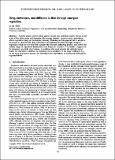Drag, turbulence, and diffusion in flow through emergent vegetation
Author(s)
Nepf, Heidi
DownloadNepf-1999-Drag, trubulence.pdf (1.053Mb)
PUBLISHER_POLICY
Publisher Policy
Article is made available in accordance with the publisher's policy and may be subject to US copyright law. Please refer to the publisher's site for terms of use.
Terms of use
Metadata
Show full item recordAbstract
Aquatic plants convert mean kinetic energy into turbulent kinetic energy at the scale of the plant stems and branches. This energy transfer, linked to wake generation, affects vegetative drag and turbulence intensity. Drawing on this physical link, a model is developed to describe the drag, turbulence and diffusion for flow through emergent vegetation which for the first time captures the relevant underlying physics, and covers the natural range of vegetation density and stem Reynolds' numbers. The model is supported by laboratory and field observations. In addition, this work extends the cylinder-based model for vegetative resistance by including the dependence of the drag coefficient, CD, on the stem population density, and introduces the importance of mechanical diffusion in vegetated flows.
Date issued
1999-02Department
Massachusetts Institute of Technology. Department of Civil and Environmental EngineeringJournal
Water Resources Research
Publisher
American Geophysical Union
Citation
Nepf, H. M. “Drag, turbulence, and diffusion in flow through emergent vegetation.” Water Resources Research 35.2 (1999): 479. © 1999 American Geophysical Union
Version: Final published version
ISSN
0043-1397